
A garden-path blog post
Garden-path sentences are grammatically correct sentences that are easily misunderstood. Only after reading the whole sentence, the grammatical relations between the words unfold –the meaning of the sentence will therefore take you by surprise. For example: The complex houses married and single soldiers and their families. In this sentence, the word ‘houses’ is initially confused for a noun instead of a verb. The sentence would need some serious restructuring to convey it’s intended message. Therefore, it is good writing practice to avoid garden-path sentences whenever you can, to prevent misinterpretations.
I had to think back to an English lesson about garden-path sentences, when I was strolling around the new garden path in the back of our faculty garden, opposite to the Bouman building (next to the parking lot).
Garden-path sentences owe their name to exactly such garden paths, because each bend gives you a different view and may take you by surprise. I had this exact experience when I was walking the new path in the back of our faculty garden.
The path was finalized in the fall of 2020, and paves the way through a part of the garden that had been unexplored and undisturbed for decades. Until now!
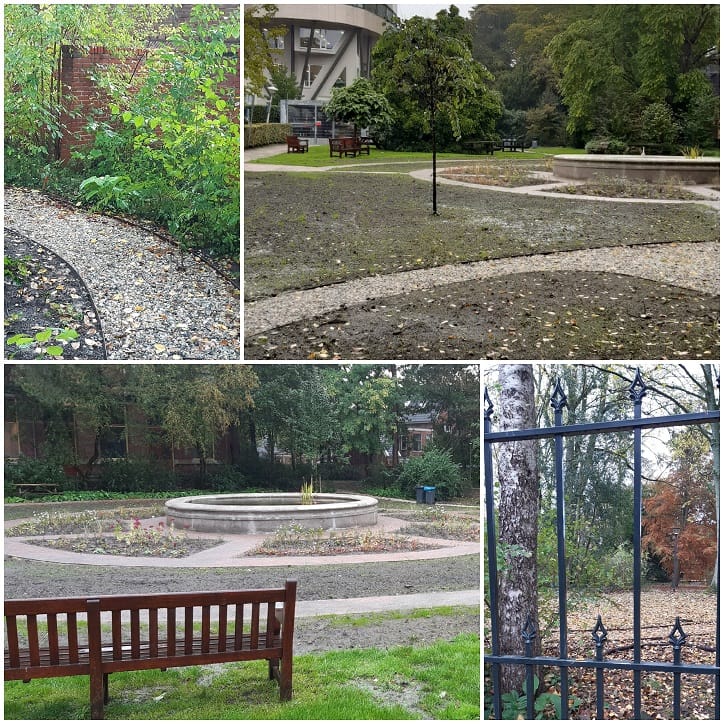
Some surprising views from the new garden path
Walking the path becomes even more surprising if you imagine what this garden looked like in ancient times, when the garden served function as the botanical garden of the university. After it’s foundation by Henricus Munting in the 17th century, it was in use as the university botanical garden for 325 years. It was only after the removal in 1966 to it’s new location in Haren (Hortus Botanicus Haren) that the behavioural sciences could made their entrance into the buildings surrounding the garden, which happened in 1988. Before that time, the Bouman building (now hosting the department of Sociology) hosted a botanical laboratory, and a pharmaceutical laboratory was located on the spot of the current Gadourek building (a modern multifunctional building). Because of it’s historical function as the Hortus Botanicus, our faculty garden is nowadays called ‘Oude Hortus’.
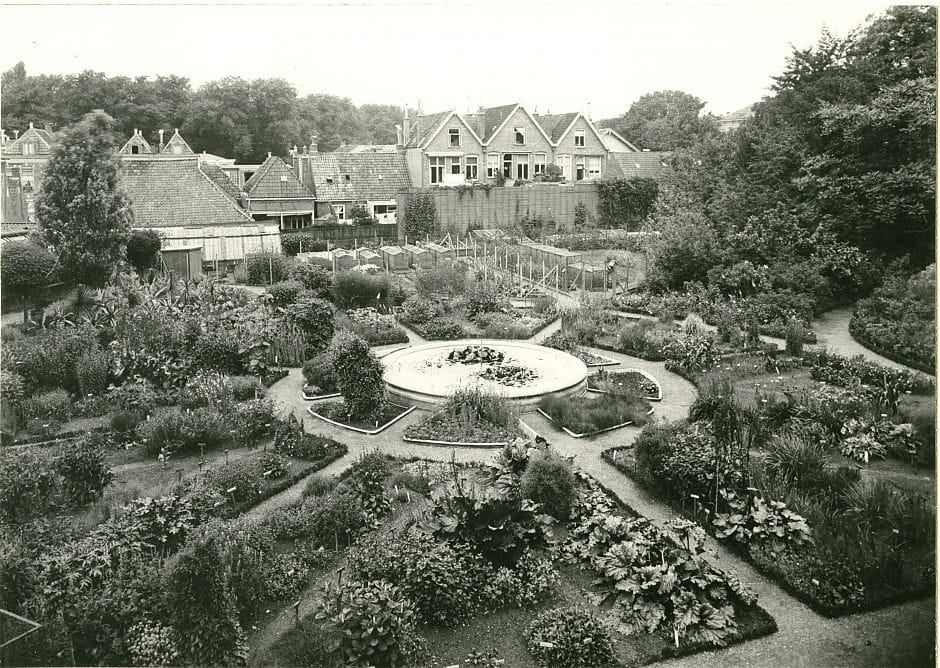
The herb garden in 1913, with the water lily fountain basin as the center piece. Nowadays the green houses in the back have made place for the parking lot.
When walking the path, you may imagine that one hundred years ago this part of the garden served as the herb garden, hosting a large collection of rare plants and botanical herbs that were used for botanical and pharmaceutical research. Green houses covered a large part of the current parking lot.
The centrepiece of this garden was, and still is, the water lily fountain basin. Back when the laboratories were up, more water basins surrounded the fountain, displaying a collection of marshland plants. If you currently walk the garden path, you will find out that the fountain basin has been renovated and has been encircled by new pavement and flowerbeds.
On my garden walk preparing for this blog, I texted the lady gardener. She is one of the green-hearted people involved in the realization of the garden path. However, she wouldn’t tell me what kind of flowers are planted in the flower beds. ‘It will be a surprise!’, she told me. So we will just have to wait for spring to find out.
The renovated garden path is part of a larger ‘garden plan’ aiming to preserve the historical character of the ‘Oude Hortus’. The plan balances out two areas of the garden: the area on the side of the Munting building, containing several ancient trees, and the area on the side of the Bouman building, containing the fountain basin.
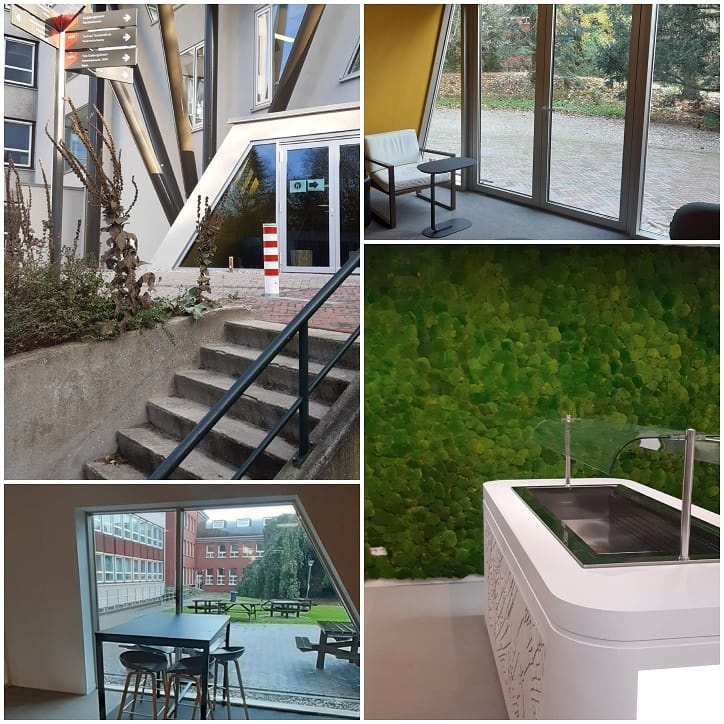
Some pictures of the new canteen, with garden-oriented views.
The new canteen and study facilities at the Heymans building are meant to provide a perfect fit to this ‘garden plan’. Now, two years after the start of the project, the demolition and construction work has finally finished, and the new construction offers numerous study places with many beautiful glimpses into the garden through so-called bay windows. When you’re in need of a break or a chat, there’s a coffee room on the first floor; downstairs, you can find the new canteen offering 250 places (that is, not taking Corona measures into account – these days the capacity is temporarily much more limited). The canteen offers several informal seats at the bay windows, giving you the feeling of sitting outside. Real moss on one of the canteen walls further emphasizes the connection with the garden.
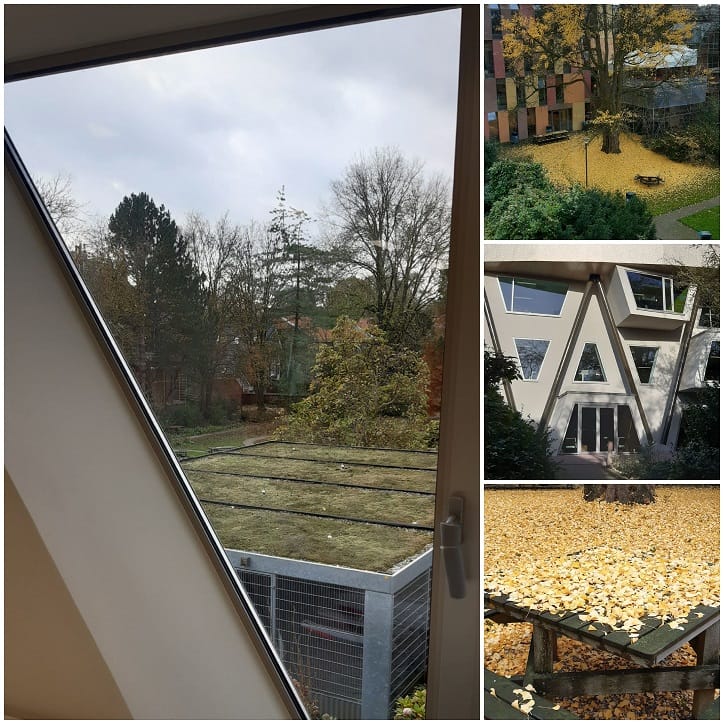
The bay windows offer surprising glimpses into the garden. The yellow leaves are from the 125-year-old Ginkgo Biloba tree facing the Gadourek building.
So, as you see, this blog post started out with some linguistics, but it turned out to give you and update about the recent changes to the faculty garden, a little bit of its history, and how these are connected to the new construction of Heymans building.
You’ve been led down the garden path!
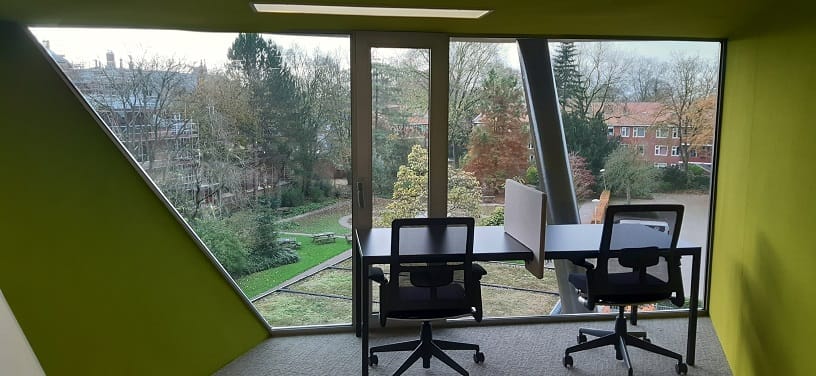
A study spot with a view on the Bouman Building, the fountain basin and the garden-path. The view may remind you to avoid writing garden-path sentences.
Image credits:
All pictures taken by Yvonne Groen, except for the historical black and white picture. The historical picture is from: P.B. Kramer, Groninger Archieven, taken over from website: https://www.deverhalenvangroningen.nl/alle-verhalen/expositie-de-hortus-botanicus
Related readings:
About the history the university botanical garden; the ‘Oude Hortus’: https://www.deverhalenvangroningen.nl/alle-verhalen/expositie-de-hortus-botanicus
About the current university botanical garden; the ‘Hortus Botanicus, Haren’: https://www.hortusharen.nl/en/welcome/
About the construction project at the Heymans building: https://www.rug.nl/gmw/bouw/
About our faculty garden: https://mindwise-groningen.nl/the-green-heart-of-our-faculty/
About garden path sentences: http://www.fun-with-words.com/ambiguous_garden_path.html
Previous blog posts about the faculty garden:
https://mindwise-groningen.nl/the-green-heart-of-our-faculty/
https://mindwise-groningen.nl/the-green-heart-lives-on/



